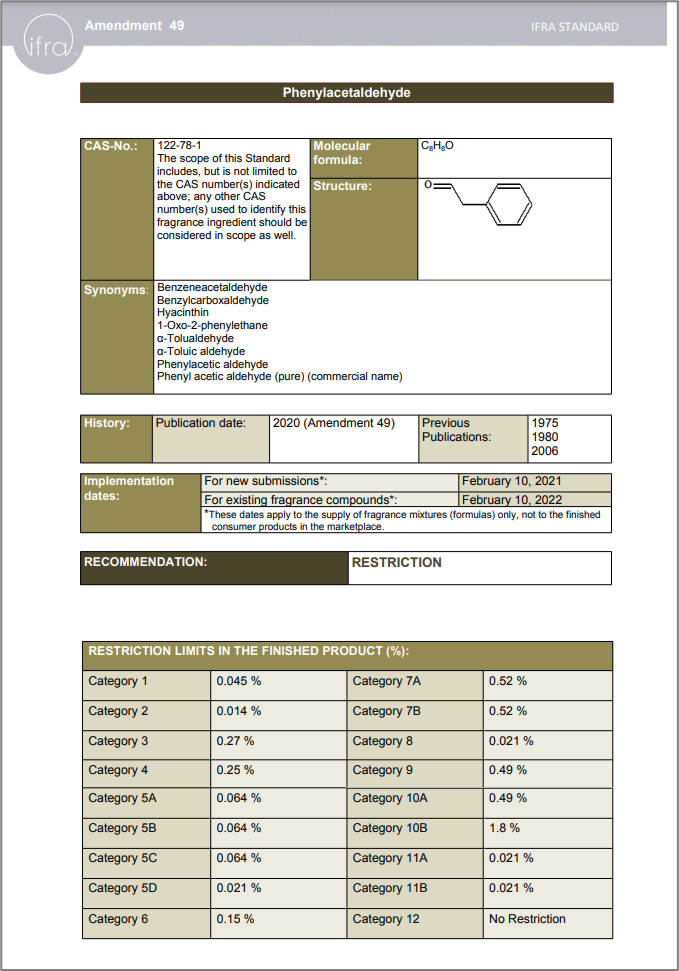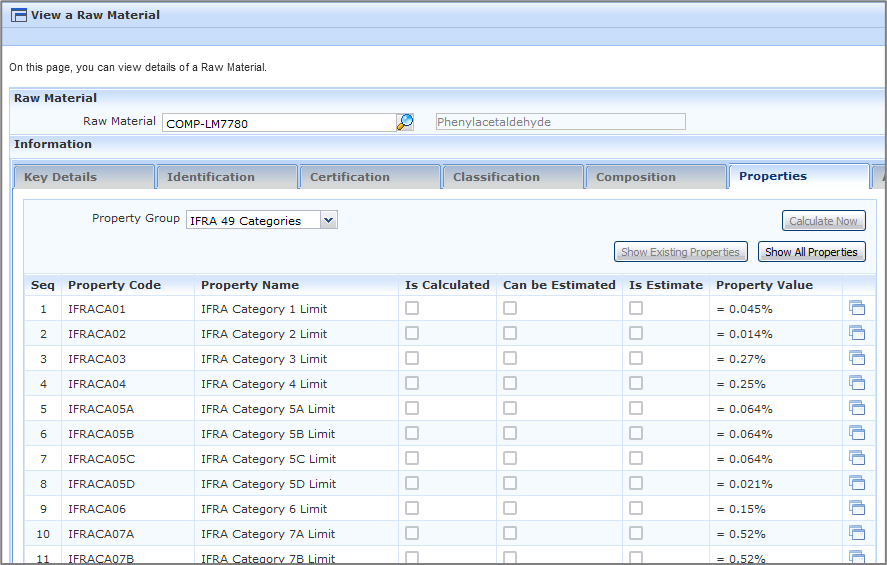How do I know which component to reduce to make my IFRA limit compliant?
IFRA Background
IFRA Issue Standards for individual chemicals, groups of chemicals and even Natural Complex Substances (NCS) there are currently over 200 Standards, some banning the use in Fragrance, limiting the use in Fragrance, or applying a specification, for example, in order to use a specific material, it may have to have a minimum purity, or not contain more than a given level of a specific impurity
The limits are based on really quite complex calculations involving taking raw test data regarding skin sensitisation, systemic toxicity, phototoxicity (causing cancer on skin when subject to UV light) and use factors such as how much exposure there is, how often exposure is, to which type of skin exposure is etc
Based on the above factors, real fragrance uses are assigned into one of 12 Categories (with some sub-categories)
These are listed at the end of any IFRA Certificate printed from Formpak
Example of IFRA Standard

So, for example, this chemical, Phenylacetaldehyde, may not be used at more than 0.25% in a Category 4 Product (e.g. an EDT)
How IFRA Limits work
In Formpak there is a Percent Property for each Category (e.g. IFRACA04) with a Calculation Type ‘Non Cumulative (Percent Only)’. The above values are assigned to the Property on each relevant Raw Material

When a Composition contains the Raw Material, a value for the same Property is calculated based on the amount present, however, this typically represents the fragrance and not the end use product
If, for example, a Formulation representing a fragrance contains 0.25% Phenylacetaldehyde it would be unrestricted in Category 4 products, however, a Formulation representing a fragrance that contains 0.5%, would only be allowed up to 50% in Category 4 products
The Maths
Maximum Use in End Use (Dosage) = (Limit / Amount in Composition) x 100
= (0.25 / 0.5) x 100 = 50%
This gets slightly more complicated when there are more than one IFRA restricted components. The Maximum End Use is always the lowest value for each of the components
Item Analysis Report
There are IFRA Item Analysis Reports which display the values of the IFRA Category Properties; however, they are not terribly easy to interpret into a maximum level at which a given Component may be present for a certain fragrance dosage
By arranging the formulation above, we can see the maximum Component level in the fragrance
Amount in Composition = Limit / (Dosage / 100)
= 0.25 / (50/100) = 0.5%

- a. Maximum fragrance dosage allowed to be used in a Category 4 product – underneath are the individual Category 4 limits for each component
- b. The Total Fractional Value of the IFRA contribution – This is always the highest value from the list below (This is a bit complex, but it’s basically how many times over the limit the hazard is – it’s equal to the Amount / Limit) – underneath are the TFV values for each component
- c. Amount of each Component in the fragrance Formulation
What components need reducing for compliance?
In order to comply for any given dosage, it may be necessary to reduce one or more components.
Scenario – The creator of this fragrance Formulation wishes it to be used in an EDT at 5%
Currently, the maximum use level is 3.75% (a.)
As the Citral is providing the highest TFV (26.66), we start by looking at its reduction
Amount in Composition = Limit / (Dosage/100)
The limit for Citral is 0.6 (column under a.) and the required dosage is 5%, so
Amount = 0.6 / (5/100) = 0.6/0.05 = 12
Therefore, we need to reduce the amount of Citral from 16 parts to 12 parts
Is that it, is there more?
There could be more than one component limiting the maximum end use dosage, so we can ascertain what the maximum TFV is for our given dosage and check the list to see if any more exceed it
TFV = Amount / Limit
For Citral, at its new compliant amount of 12 parts, the TFV = 12/0.6 – 20.0
Therefore, if any other TFVs in the list exceed 20, they too must be reduced
In this case there are none, so only Citral must be reduced from 16 parts to 12 parts

The Item Analysis report now shows the maximum dosage is 5%
February 2024





















